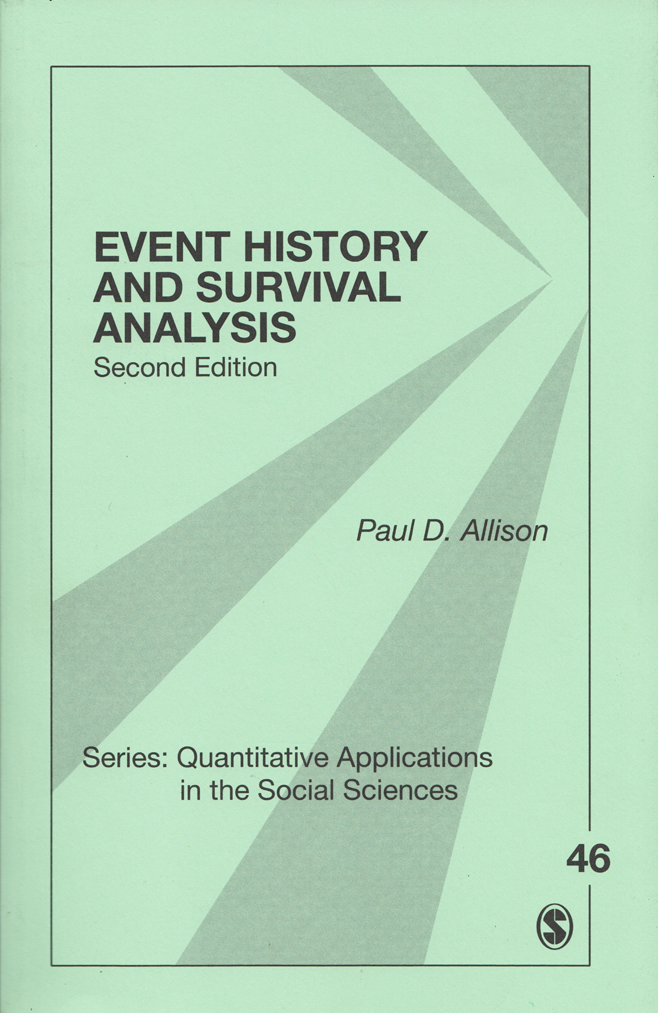

2025 Stata Conference • Nashville, TN • 31 July–01 August
Event History and Survival Analysis, Second Edition |
||||||||||||||||||||||||||||||||||||
 Click to enlarge See the back cover |

As an Amazon Associate, StataCorp earns a small referral credit from
qualifying purchases made from affiliate links on our site.
eBook not available for this title
eBook not available for this title |
|
||||||||||||||||||||||||||||||||||
Comment from the Stata technical groupEvent History and Survival Analysis, Second Edition is a concise yet substantive book that discusses the main techniques currently used for modeling survival analysis. Mathematical formulas have been kept to a minimum throughout the book and mostly relegated to an appendix. Instead, the book focuses on the fundamental concepts; for example, you will find a discussion on the different kinds of censoring and on how to perform sensitivity analysis for the noninformative assumption. The book starts by discussing models for discrete-time survival analysis. Then it moves on to models for continuous time, first addressing parametric models and then the Cox proportional hazards model. Finally, it discusses more advanced topics such as multiple types of events, which include competing risks and repeated events. The author guides the readers through these models by explaining different examples from the social sciences. Stata (and SAS) code to reproduce those examples, as well as the datasets used in the book, are available online. This book constitutes an excellent resource for learning survival analysis, and we also recommend it as a reference for any researcher who works with event history data. |
||||||||||||||||||||||||||||||||||||
Table of contentsView table of contents >>
About the Author
Series Editor's Introduction
John Fox
Preface to the Second Edition
1. Introduction
Problems in the Analysis of Event Histories
An Overview of Event History Methods Computing
2. Discrete-Time Methods
A Discrete-Time Example
The Discrete-Time Hazard A Logistic Regression Model Estimating the Model Estimates for the Biochemistry Example The Likelihood-Ratio Chi-Square Test Issues With the Discrete-Time Logistic Method Censoring Discrete Versus Continuous Time
3. Parametric Methods for Continuous-Time Data
The Continuous-Time Hazard Rate
Parametric Proportional Hazards Method Maximum Likelihood Estimation An Empirical Example Accelerated Failure Time Models Evaluating Model Fit Unobserved Sources of Heterogeneity Why Parametric Models?
4. Cox Regression
The Proportional Hazards Model
Partial Likelihood Partial Likelihood Applied to the Recidivism Data Time-Varying Explanatory Variables Testing and Relaxing the Proportional Hazards Assumption Choice of Origin for the Measurement of Time Cox Regression for Discrete-Time Data Predictions Based on the Cox Model
5. Multiple Kinds of Events
A Classification of Multiple Kinds of Events
Estimation for Parallel Processes Models for Competing Risks An Empirical Example of Competing Risks Dependence Among Different Kinds of Events Cumulative Incidence Functions
6. Repeated Events
Count Data Models for Repeated Events
Methods Based on Gap Times Methods Based on Times Since Origin Extensions
7. Conclusion
Appendix
Maximum Likelihood
Partial Likelihood Discrete-Time Likelihood Function for Non-Repeated Events
References
Index
|
||||||||||||||||||||||||||||||||||||
Learn
Free webinars
NetCourses
Classroom and web training
Organizational training
Video tutorials
Third-party courses
Web resources
Teaching with Stata
© Copyright 1996–2025 StataCorp LLC. All rights reserved.
×
We use cookies to ensure that we give you the best experience on our website—to enhance site navigation, to analyze usage, and to assist in our marketing efforts. By continuing to use our site, you consent to the storing of cookies on your device and agree to delivery of content, including web fonts and JavaScript, from third party web services.
Cookie Settings
Last updated: 16 November 2022
StataCorp LLC (StataCorp) strives to provide our users with exceptional products and services. To do so, we must collect personal information from you. This information is necessary to conduct business with our existing and potential customers. We collect and use this information only where we may legally do so. This policy explains what personal information we collect, how we use it, and what rights you have to that information.
These cookies are essential for our website to function and do not store any personally identifiable information. These cookies cannot be disabled.
This website uses cookies to provide you with a better user experience. A cookie is a small piece of data our website stores on a site visitor's hard drive and accesses each time you visit so we can improve your access to our site, better understand how you use our site, and serve you content that may be of interest to you. For instance, we store a cookie when you log in to our shopping cart so that we can maintain your shopping cart should you not complete checkout. These cookies do not directly store your personal information, but they do support the ability to uniquely identify your internet browser and device.
Please note: Clearing your browser cookies at any time will undo preferences saved here. The option selected here will apply only to the device you are currently using.